#PC Engine Super CD-ROM²
Explore tagged Tumblr posts
Photo
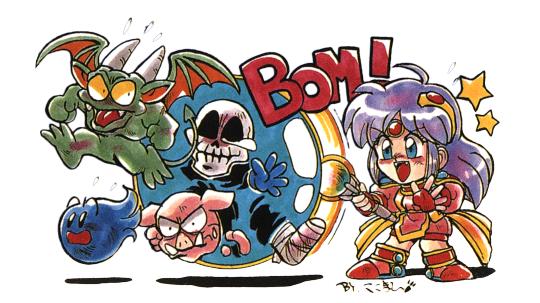
Bom! 'Pop'n Magic' PC Engine Super CD-ROM²
638 notes
·
View notes
Text

Juegos ds Sailor Moon para PC Engine Super CD-Rom.
Sailor Moon games for the PC Engine Super CD-Rom.
#retro#retrogaming#videojuegos#sailor moon#bishoujo senshi sailor moon#pc engine#cd rom game#cd rom#pc engine super cd rom#videogame
18 notes
·
View notes
Text

Promotional poster for "Galaxy Fräulein Yuna 2: Eternal Princess" for the PC Engine Super CD-ROM², Hudson Soft, 1995
77 notes
·
View notes
Text
The song "Pascal's Theme" from the game 'Shin Megami Tensei', a 1992 role-playing game developed and published by Atlus. Initially released on Super Nintendo, followed by PC Engine CD-ROM (1993), Mega-CD (1994), Playstation (2001), Gameboy Advance (2003), and finally iOS and Android (2012).
youtube


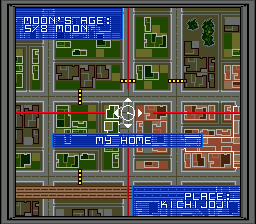

-Submission by @vinegar-on-main
15 notes
·
View notes
Photo



Snatcher (PC-Engine Super CD-ROM² - 1992 - Konami)
This is the comic that came in the manual.
83 notes
·
View notes
Text
Sega Mega Drive - Dragon Slayer: The Legend of Heroes
Title: Dragon Slayer: The Legend of Heroes / ドラゴンスレイヤー英雄伝説
Developer/Publisher: Sega / Nihon Falcom
Release date: 16 September 1994
Catalogue No.: G-5542
Genre: RPG
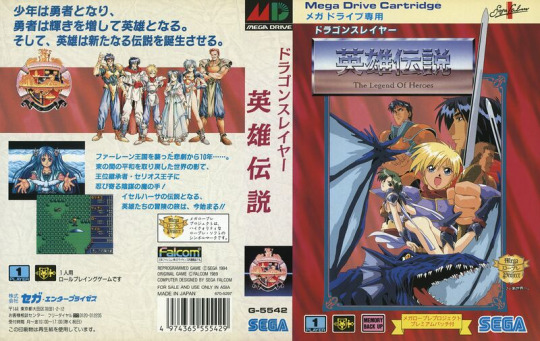
Late in the Mega Drive's life, Sega realized they were missing out big time to the RPG fans running to the Super Famicom in droves. So, Sega decided to get some of those players back on side with the "Mega RPG Project" that would feature new games and remakes of classic RPGs brought to the system. One such classic was Dragon Slayer. Now, Dragon Slayer may not be a big name in the West but back in Japan, it was massive and just as popular as Dragon Quest, Xenoblade, and Final Fantasy. After having much success on the Japanese home computers (MSX 2, FM Towns, PC-8801mkII SR, and PC-9801) and PC Engine (in Super CD-ROM format) as well as a Super Famicom version by Epoch, Dragon Slayer came to the Mega Drive with pretty decent success that spawned a sequel that also earned a spot on the Mega Drive.
Dragon Slayer is a lot of fun precisely because of its uncomplicated but not undemanding gameplay. With its great presentation and a beautiful, very dense, and well-told story for its age, it is definitely a winner for me. The anime cutscenes, the ability to save anywhere in the game, the absolutely exemplary continue function after a premature death, and the balanced difficulty level, which avoids unnecessary leveling up and thus boredom, make the experience absolutely perfect.
Graphically, Dragon Slayer may look dated these days but does support some very nice cut scenes and music. A true Japanese RPG classic.



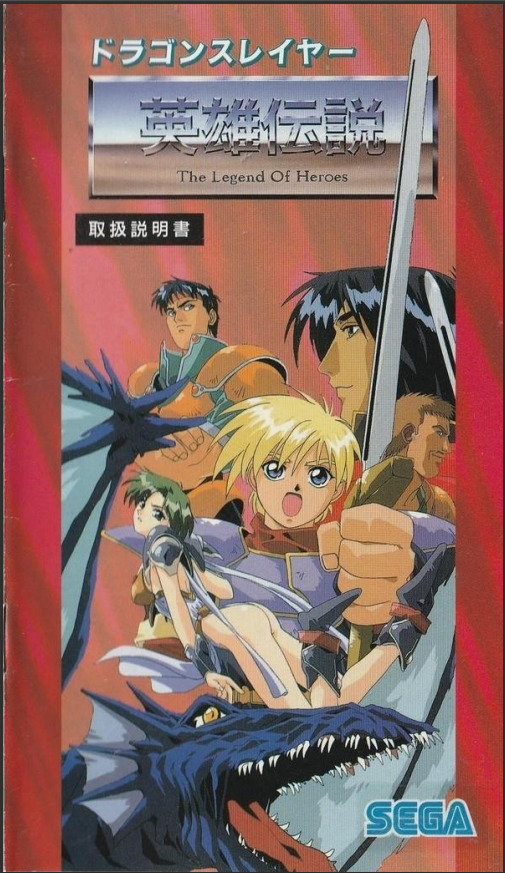

youtube
10 notes
·
View notes
Note
what old game do you think made the most or best use of its hardware?
I've been thinking over this one for a bit, and in the end I can't think of a game that punches above its weight more than Castlevania: Rondo of Blood for the PC Engine CD + Super System
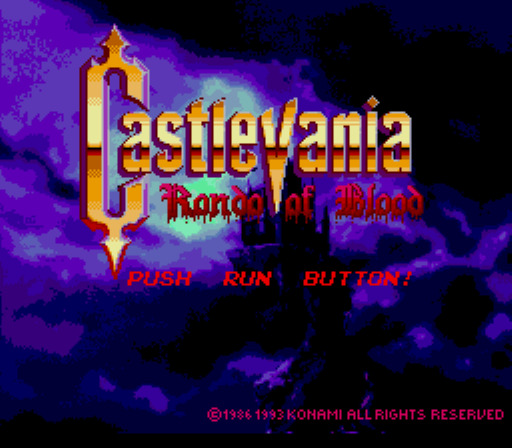
Rondo of Blood is really one of the best games of its era. It's got some incredibly tight gameplay that I feel no other game of its style has quite managed to capture, it has some amazing music, and it's an absolute FEAST on the eyes with how it's filled with vibrant graphics and silky smooth pixel animations.

While Rondo stands as a great game on its own, when we look into the hardware it's running on we can really tell how much the game is pushing this console. Many people I've met whose only exposure to the PC Engine comes from Rondo think the console is some sort of "powerhouse", that it's very good at pushing these gorgeous 2D visuals in a way at least comparable to other consoles of its time, like the SNES or Genesis. This couldn't be farther from the truth.
The base PC Engine console was a budget system, meant to be a 16-bit upgrade for people who couldn't afford or couldn't wait for the bigger consoles. Internally tho, while its graphics might seem 16-bit enough, the console is actually not too different from the old NES, just with a tiny bit more juice. The CD-ROM² expansion lets it read data off discs. And finally the Super System Card is an expansion to the CD expansion that gives it a bit more RAM to play around it. That's it, that's what Rondo runs on. Just an NES with a CD drive and some extra RAM.
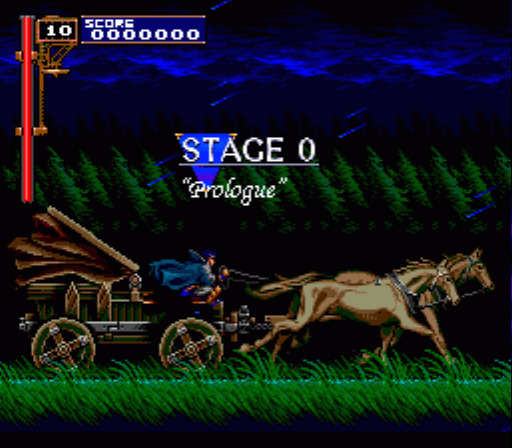
Rondo largely manages to look as good as it does by just knowing very well how to use the hardware. How to split the screen into strips to give the illusion of perspective or background layers. How to add sprites every now and then to make the background's strips blend in. It also helps that for a console like this a CD is practically infinite storage space, making RAM the only real concern in that regard. Really the only aspect of the PC Engine that goes underutilized is the audio chip, and that's because of the music all being streamed.
Rondo is a game I could gush about for hours, so I think I'll cut it short here. As a fun anecdote, before settling on Rondo I asked my partner for their thoughts on this, to which they replied "probably something like The Last of Us or the Wii Sports game" which uh. Isn't wrong! But still filled me with an indescribable dread...
#thanks for the ask!!! :3#this game looks a lot better in motion but i dont feel like going through the hassle of actually making gifs....#ess rambles
25 notes
·
View notes
Text

(1997) Super PCEngine Fan Deluxe Special CD-Rom
so, there are two of these, but the first one is a single track and the second one includes that same track.
this is a disc that came with the Super PC Engine Fan magazine. perusing the accompanying magazine, Toshiyuki Ueno is credited to the music but idk if it's all his work or if he just selected what tracks to feature...
i just have the flac rips. they're ok. i kinda like where 20.flac is going. 26.flac, the one song both volumes share, is prolly the best.
i have no screenshot so the pic is a clipping from the magazine lol
2 notes
·
View notes
Text
Marukatsu PC Engine Vol. 43 (Jul. 1992) - Snatcher CD-ROMantic interview


Breaking News! Konami joins the Super CD-ROM² Market
It was a bright day in Kobe... sort-of! Anyway, upon hearing the rumor of Konami joining the Super CD-ROM² market, we the news crew of Marukatsu PC Engine magazine enthusiastically set out to Konami's technical research institute in Kobe. We were greeted by the deputy director of the institute Mr. Akihiko Nagata, senior staff member Mr. Hideo Kojima, and our beautiful public relationist Ms. Taeko Hayasaka. Since we're all in good company here (whatever that means), let's begin with our interview.
So, let's start with the reason why Konami decided to join the Super CD-ROM² market.
Hayasaka: Ever since we've entered the PC Engine market last year, we've been receiving many letters asking us when are we going to put out a game on the Super CD-ROM² format. Those frank opinions were the reasons [for joining the Super CD-ROM² market]. Not just Super CD, but we at Konami wish to be a manufacturer that reflects the wishes of our customers into our products.
Was the decision to make Snatcher your company's first Super CD-ROM² release was also a reflection of your users wishes?
Hayasaka: That's right. It was a frequently requested title on survey cards submitted by our customers.
Nagata: We were undecided whether we wanted to do a port of an existing game or a completely new one, but there was a strong desire from our developers to do Snatcher. (He glances at Kojima while stating this. What secret is he hiding? He's none other than the original author for Snatcher.)
Kojima: This new Super CD version of Snatcher surpasses the old one. Please look forward to it.
By surpassing the previous version, you mean it won't be just a simple port, but it'll have new things to experience...?
Nagata: Well, it is a Super CD after all. Unlike the original home computer version, the characters now speak their lines. We had a splendid cast for our voice actors.
Hayasaka: Let me introduce some of them. The game's protagonist, Gillian Seed, is voiced by Yusaku Yara, who played the dad in Chibi Maruko-chan. His wife Jaime is voiced by Kikuko Inoue, who played Electra in Nadia and the Secret of Blue Water. And then there's Metal Gear, who is voiced by Mami Koyama, the voice of Arale from Dr. Slump. Isn't that an amazing lineup?
We're looking forward to hearing them. So that means a lot of effort is going to be put into the animation side as well?
Kojima: That's right. We're employing full use of the CD-ROM media capacity and put lots of new features in the game that were not possible in the old home computer versions. Even the story will have additions that will greatly increase its sense of completeness, so as a member of the game's staff, I would like to consider it to be the most definitive version. Of course, all the mysteries that were left lingering in the old PC versions will be answered in this new Super CD version.
In other words, there will be a concluding act?
Kojima: That's right. The Super CD-ROM² version will be divided into three acts, an exciting ending has been prepared for Act 3. I think newcomers, as well as players already familiar with the PC version will enjoy it.
I see. It sounds more and more exciting! By the way, are there any other plans for the Super CD-ROM² format?
Hayasaka: We're planning on doing ports, as well as all-new games. We are going to try to put out software that everyone will enjoy to the best of our abilities. We're also considering making an all-new game for the Hu-Card format. We will eventually reveal them to everyone interested. (smile)
8 notes
·
View notes
Text
Hell is terms like ASIC, FPGA, and PPU
I haven't been doing any public updates on this for a bit, but I am still working on this bizarre rabbit hole quest of designing my own (probably) 16-bit game console. The controller is maybe done now, on a design level. Like I have parts for everything sourced and a layout for the internal PCB. I don't have a fully tested working prototype yet because I am in the middle of a huge financial crisis and don't have the cash laying around to send out to have boards printed and start rapidly iterating design on the 3D printed bits (housing the scroll wheel is going to be a little tricky). I should really spend my creative energy focusing on software development for a nice little demo ROM (or like, short term projects to earn money I desperately need) but my brain's kinda stuck in circuitry gear so I'm thinking more about what's going into the actual console itself. This may get techie.
So... in the broadest sense, and I think I've mentioned this before, I want to make this a 16-bit system (which is a term with a pretty murky definition), maybe 32-bit? And since I'm going to all this trouble I want to give my project here a little something extra the consoles from that era didn't have. And at the same time, I'd like to be able to act as a bridge for the sort of weirdos who are currently actively making new games for those systems to start working on this, on a level of "if you would do this on this console with this code, here's how you would do it on mine." This makes for a hell of a lot of research on my end, but trust me, it gets worse!
So let's talk about the main strengths of the 2D game consoles everyone knows and loves. Oh and just now while looking for some visual aids maybe I stumbled across this site, which is actually great as a sort of mid-level overview of all this stuff. Short version though-
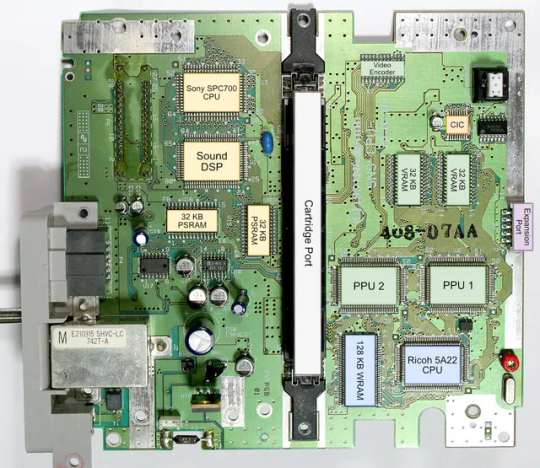
The SNES (or Super Famicom) does what it does by way of a combination of really going all in on direct memory access, and particularly having a dedicated setup for doing so between scanlines, coupled with a bunch of dedicated graphical modes specialized for different use cases, and you know, that you can switch between partway through drawing a screen. And of course the feature everyone knows and loves where you can have one polygon and do all sorts of fun things with it.
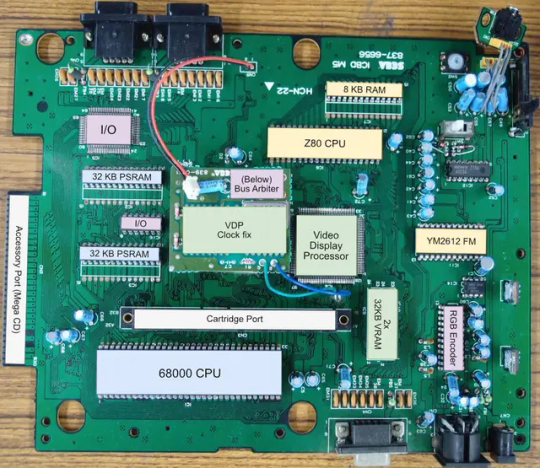
The Genesis (or Megadrive) has an actual proper 16-bit processor instead of this weird upgraded 6502 like the SNES had for a scrapped backwards compatibility plan. It also had this frankly wacky design where they just kinda took the guts out of a Sega Master System and had them off to the side as a segregated system whose only real job is managing the sound chip, one of those good good Yamaha synths with that real distinct sound... oh and they also actually did have a backwards compatibility deal that just kinda used the audio side to emulate an SMS, basically.
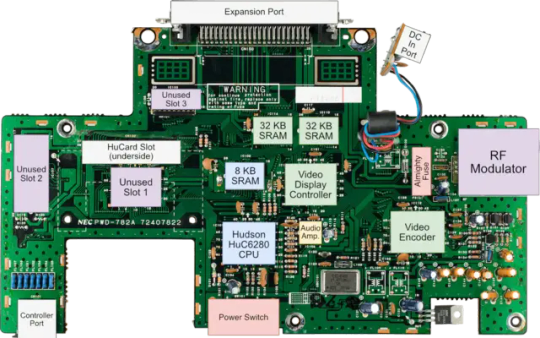
The TurboGrafix-16 (or PC Engine) really just kinda went all-in on making its own custom CPU from scratch which...we'll get to that, and otherwise uh... it had some interesting stuff going on sound wise? I feel like the main thing it had going was getting in on CDs early but I'm not messing with optical drives and they're no longer a really great storage option anyway.
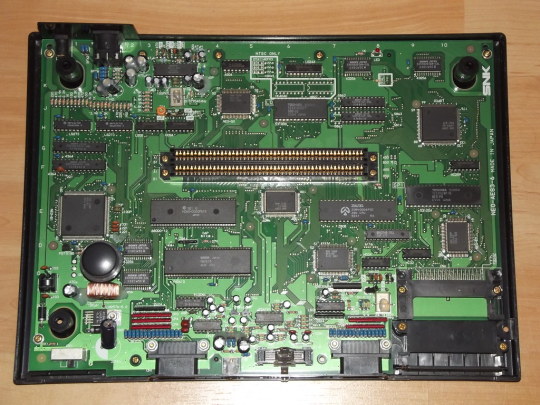
Then there's the Neo Geo... where what's going on under the good is just kind of A LOT. I don't have the same handy analysis ready to go on this one, but my understanding is it didn't really go in for a lot of nice streamlining tricks and just kinda powered through. Like it has no separation of background layers and sprites. It's just all sprites. Shove those raw numbers.
So what's the best of all worlds option here? I'd like to go with one of them nice speedy Motorolla processors. The 68000 the Genesis used is no longer manufactured though. The closest still-in-production equivalent would be the 68SEC000 family. Seems like they go for about $15 a pop, have a full 32-bit bus, low voltage, some support clock speeds like... three times what the Genesis did. It's overkill, but should remove any concerns I have about having a way higher resolution than the systems I'm jumping off from. I can also easily throw in some beefy RAM chips where I need.
I was also planning to just directly replicate the Genesis sound setup, weird as it is, but hit the slight hiccup that the Z80 was JUST discontinued, like a month or two ago. Pretty sure someone already has a clone of it, might use that.
Here's where everything comes to a screeching halt though. While the makers of all these systems were making contracts for custom processors to add a couple extra features in that I should be able to work around by just using newer descendant chips that have that built in, there really just is no off the shelf PPU that I'm aware of. EVERYONE back in the day had some custom ASIC (application-specific integrated circuit) chip made to assemble every frame of video before throwing it at the TV. Especially the SNES, with all its modes changing the logic there and the HDMA getting all up in those mode 7 effects. Which are again, something I definitely want to replicate here.
So one option here is... I design and order my own ASIC chips. I can probably just fit the entire system in one even? This however comes with two big problems. It's pricy. Real pricy. Don't think it's really practical if I'm not ordering in bulk and this is a project I assume has a really niche audience. Also, I mean, if I'm custom ordering a chip, I can't really rationalize having stuff I could cram in there for free sitting outside as separate costly chips, and hell, if it's all gonna be in one package I'm no longer making this an educational electronics kit/console, so I may as well just emulate the whole thing on like a raspberry pi for a tenth of the cost or something.
The other option is... I commit to even more work, and find a way to reverse engineer all the functionality I want out with some big array of custom ROMs and placeholder RAM and just kinda have my own multi-chip homebrew co-processors? Still PROBABLY cheaper than the ASIC solution and I guess not really making more research work for myself. It's just going to make for a bigger/more crowded motherboard or something.
Oh and I'm now looking at a 5V processor and making controllers compatible with a 10V system so I need to double check that all the components in those don't really care that much and maybe adjust things.
And then there's also FPGAs (field programmable gate arrays). Even more expensive than an ASIC, but the advantage is it's sort of a chip emulator and you can reflash it with something else. So if you're specifically in the MiSTer scene, I just host a file somewhere and you make the one you already have pretend to be this system. So... good news for those people but I still need to actually build something here.
So... yeah that's where all this stands right now. I admit I'm in way way over my head, but I should get somewhere eventually?
11 notes
·
View notes
Text
Abandonware and Nostalgia
I was recently watching a YouTube video where this guy was exploring a Garry’s Mod map when he mentioned an old CD-ROM game he played as a kid (the specific story is from 14:00-15:16). It’s called Crayola 3D Castle Creator. Something that really caught my attention was when he mentioned a jester character and old 3D graphics. I did a quick Google search and managed to find it quite easily.
Now, tell me… does the jester on the cover look somewhat familiar to y'all or is it just me?


Granted, the actual character in the game doesn’t look anything like they do on the cover…

Eugh. Like, seriously, what is that thing? …but anyway, there’s still an uncanny resemblance in the cover art that I can’t unsee. I wonder if there's any subtle inspiration for Pomni’s design stemming from this game? Probably not but it’s a neat little similarity either way :)
Also, even though you can’t really play the game anymore unless you have a computer that runs Windows 98, I was able to find a version of the game that you can download (though it may not be entirely playable as I haven't tested it myself) on MyAbandonware! It’s essentially a super cool website that has a massive collection of abandoned/dead games you can still download, although some need an emulator or specific PC specs, as with any game.
It kinda dragged me down a rabbit hole of learning what actually counts as abandonware. This particular website is just one of many internet archives for software archaeologists to preserve games that might otherwise be lost to time, some of which are the only pieces of media to use their specific game engines. It’s really neat stuff, and super useful for historical preservation purposes!
Anyway, I’ll post more about all that stuff later, but just know that all this research has certainly given me some... ideas for the fic… ;)c
#abandonware#tadc pomni#autistic ramblings#I just think this stuff is so cool#lowkey giving me ideas#don't worry about it
10 notes
·
View notes
Photo

Take Care Of Your CDs! 'Pop'n Magic' PC Engine Super CD-ROM²
339 notes
·
View notes
Text
Super Darius (TG-16 Mini)
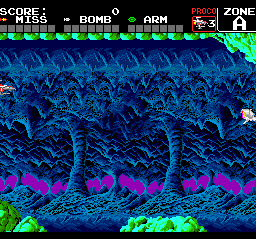
As if the console needed more shoot 'em up feathers in its cap, the PC Engine CD-ROM played host to the first console port of Taito's Darius. Super Darius is a give-and-take port. On the positive side, you get some new bosses that were cut from the arcade original. You also pick up right from where you died instead of starting back at a checkpoint, but you don't get any continues at all so you'll really need to be skilled to reach the end of the game. Ends? In terms of presentation, this is a very faithful port in terms of how it looks and sounds. There's a noticeable flicker if you're playing on the PC Engine, but the SuperGrafx mitigated that and the version on this Mini benefits from those improvements. Even with the flicker, it's an impressive port for the era.
Of course, there's one aspect of the arcade Darius that this version simply could not replicate. The game was famous for its three-screen display, and here we're obviously limited to one. That can make things feel a bit crunched at times, with some levels being considerably harder as a result. I can't really fault the port for this as there wasn't any feasible alternative way to deal with this that wouldn't involve similar sacrifices. The developers did their best, and then somehow managed to get a downgraded but similarly impressive HuCard port out of it on top of that.
It does beg the question of what Darius has going for it without that widescreen razzle-dazzle, though. This series got a lot better as it went on, and I don't think I'm saying anything controversial when I suggest that the original Darius didn't exactly trouble the best of the genre. The branching paths are a nifty idea, and the multiple endings are fun conceptually even if the game doesn't do as much with them as it could have. The soundtrack is incredible, and I think it manages to elevate the atmosphere of the game almost on its own. The fishy enemies are interesting, and we all love the warning when a boss is incoming. It's a decent enough game, one that at least built a foundation for some amazing follow-ups.
It's a nice game to have on the mini-console, too. As mentioned before, this game is enhanced when you play it on a SuperGrafx. Even if you own the original game you probably don't own one of those. This is also one of the few games not included in the Darius Cozmic Collection releases, so the TG-16 Mini is pretty much the only way to play it now short of tracking down an original copy. And even if it doesn't have quite the same impact as the arcade original, I'll never say no to another way to play Darius.
2 notes
·
View notes
Text
Edia teases Tenshi no Uta revival project
From Gematsu
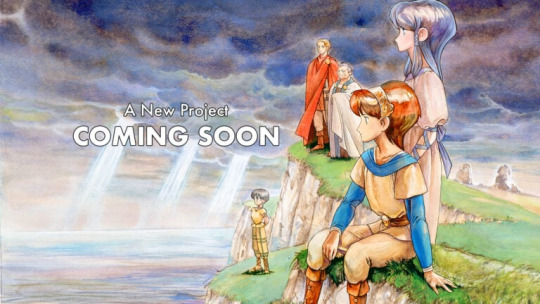
Edia has launched a teaser website for a new Telenet revival project, which features artwork with characters from the Tenshi no Uta series.
Tenshi no Uta is an RPG first launched for PC-Engine Super CD-ROM² on October 25, 1991 in Japan. It was followed by sequels Tenshi no Uta II: Datenshi no Sentaku and Tenshi no Uta: Shiroki Tsubasa no Inori.
Edia previously released Telenet Shooting Collection for Switch, which included classic Telenet Japan shoot ’em up games Granada, Avenger, Gaiares, and Psychic Storm.
Follow Edia’s “Telenet Revival” project on Twitter @TelenetRevive.
#Tenshi no Uta#Telenet#Edia#RPG#PC Engine#Gematsu#Never heard of this but it's good to have old Japanese PC games brought back.
2 notes
·
View notes
Text
The song is "Innocent Girl" from the game 'Snatcher', a 1988 graphic adventure game developed and published by Konami. Originally released on the NEC PC-8801
youtube
An interesting history, this game was actually written and designed by Hideo Kojima and had a multitude of releases. Because of the sound chips used in the variety of consoles of the different eras, each version of the track sounded unique. Included below are the comparisons both in video and audio format
youtube
Other releases include the MSX2 in 1988, PC Engine Super CD-Rom in 1992, Sega CD/Mega CD in 1994, and then finally nearly a decade later on Sega Saturn / Sony Playstation in 1996
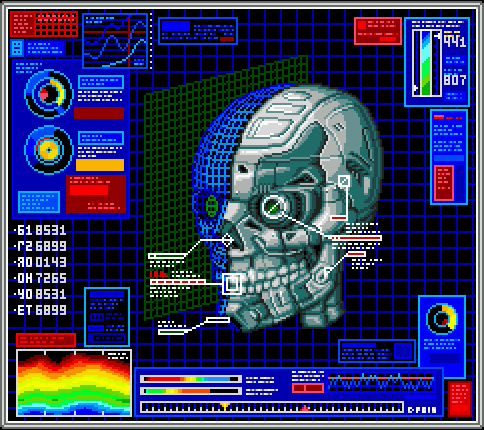
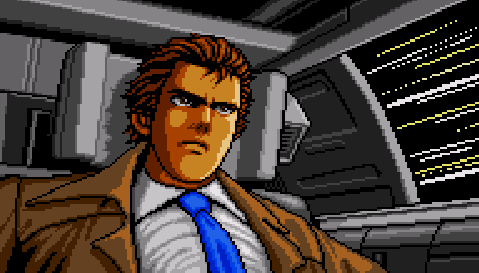

18 notes
·
View notes
Video
youtube
Handheld Fighting Games of 89/94 - Fatal Fury Special
The 1994 Game Gear release of Fatal Fury Special brought the iconic 2D fighting experience to a portable platform, allowing fans to enjoy the action on the go. Developed by SNK, this enhanced version of Fatal Fury 2 introduced a larger roster of fighters, including returning characters like Terry and Andy Bogard, Mai Shiranui, and the formidable Wolfgang Krauser. Notably, this instalment made the previously unplayable bosses from Fatal Fury 2 immediately available and reintroduced fan favourites such as Duck King, Tung Fu Rue, and Geese Howard from the original game.
This handheld adaptation maintained the series' unique gameplay elements, such as the ability to fight across two planes, providing a pseudo-3D experience. Players could also enjoy new features, including Count Down mode, where opponents are defeated within a time limit, as well as improved background graphics and additional character color schemes. While compressed for the Game Gear’s hardware, Fatal Fury Special retained much of the excitement and depth that made it a standout in the fighting genre.
In addition to the Game Gear release, Fatal Fury Special was ported to numerous platforms between 1994 and 1996, including the Super Nintendo, Sega CD, PC Engine Arcade CD-ROM², and Japan-exclusive systems like the Sharp X68000 and FM Towns.
1. Intro 00:00 2. Gameplay 00:15 3. Outro 12:01
For other Handheld Fighting games released between 1989 and 1994 check out this playlist. https://www.youtube.com/playlist?list=PLFJOZYl1h1CG_uI1-iafuDaV2LXRQTbZH
#youtube#fighting games#handheld gaming#video games#90s games#90s gaming#classic games#retro gaming#fatal fury#fatal fury special#snk#2d fighting games#1994#handheld fighting games
1 note
·
View note